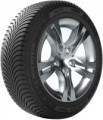Width
Tire section width is the distance between the sidewalls of an inflated but not loaded tire. As a rule, this parameter is indicated in millimeters, but there are also inch designations for the profile width.
Width is one of the characteristics that determines the compatibility of a tire with a specific wheel (the second characteristic is the mounting size). It is worth noting that the width of the tire does not have to strictly correspond to the width of the rim; certain deviations are allowed. There are special tables that allow you to determine the permissible width values for a particular wheel; in addition, such recommendations may be indicated in the documentation for a specific car.
The following tire width options are available on the modern market:
135 mm,
145 mm,
155 mm,
165 mm,
175 mm,
185 mm,
195 mm,
205 mm,
215 mm(in inches this is
8.5”),
225 mm,
235 mm,
240 mm(in inches this is
9.5”),
245 mm,
255 mm,
265 mm(in inches this is
10.5”),
275 mm,
285 mm,
290 mm(in inches this is
11.5”),
295 mm,
305 mm,
315 mm,
320 mm(in inches this is
12.5”),
325 mm,
335 mm,
345 mm(in inches this is
13.5”) and
over 345 mm(
over 13.5”).
Aspect ratio
Tyre aspect ratio. This parameter is usually expressed as a percentage of the width, since it is not the height itself that is of practical importance, but its ratio with the nominal section width.
In general, the lower the ratio, the more stable the tyre, the better it is suitable for high-speed driving on flat roads. Higher ratio, in turn, work better on rough surfaces and over obstacles, making them good for bad roads and
off-road. If we talk about specific numbers, nowadays, the following options are spread on the market:
— Low profile tyres:
25%,
30%,
35%,
40% ;
— Medium profile :
45%,
50%,
55%,
60% ;
— High profile :
65%,
70%,
75%,
80%,
82%,
85%, and
90% or more.
Tyre inner diameter
Tyre inner diameter in inches. The key parameter that determines the possibility of installing a tyre on a car: the tyre diameter must match the diameter of the rim. It is worth noting that some vehicles have +/- 1 inch diameter tolerance; this point should be clarified separately in each case.
In modern passenger vehicle tyres, the following rim diameters are most widely used:
12",
13",
14",
15",
16",
17",
18",
19",
20",
21",
22",
23",
24".
Fuel efficiency
The rolling resistance rating that the tyre corresponds to. The higher this figure, the lower the resistance, the less fuel is spent to overcome it and the more economical the tyre is. Efficiency indices are denoted by letters of the Latin alphabet in descending order of efficiency:
A(highest efficiency),
B,
C,
D,
E,
F,
G(lowest efficiency).
With other things being equal, more economical tyres tend to cost more, but the difference is offset by fuel economy.
Wet Grip
An index that determines the overall performance of a tyre on wet pavement. Lettered from
A(highest) to
G(lowest); intermediate options, respectively —
B,
C,
D,
E and
F.
The higher this indicator, the stronger the tyre grips to the wet road, the more efficient and safer it will be in difficult weather conditions. At the same time, it is worth noting that a low grip index does not mean unsuitability for driving in rain or snow — you just need to be more careful using such tyres. Conversely, a high index does not relieve the driver of the need to be careful in difficult weather conditions.
Noise Level
The average noise level created by a tyre while driving. The lower this indicator, the more comfortable this model will be, the less additional noise it will create.
Note that EU rules provide 3 categories of tyres in terms of noise.
“Quiet” are considered models with an index of up to 68 dB,
“medium” — 68 – 71 dB,
“loud” — 72 dB and above.
Rating (top list position)
The position that tyre model took in the rating based on test results. The sources of such information are major automotive magazines, car clubs, expert organizations, etc. (see "Rating Source”). Of course, tyres with similar properties are usually compared with each other — for example, winter studded tyres, summer tyres for compact cars (golf class), off-road tyres of a certain size, etc. In our catalogue, you can choose tyres of
Top 3,
Top 5 or
Top 7 different ratings.
Rating info can be very useful given that there are a wide variety of tyres on the market with similar performance. This can mislead even a specialist, not to mention ordinary motorists. And the place in the test allows you to determine the quality of tyres with a certain degree of accuracy without delving into unnecessary subtleties — and the quality is not only “on paper”, according to official info, but also in fact. However, it should be noted that the rating is given for a specific year (usually the year of manufacture of the tyre or the next one after it), and over time, the place of a certain model in the test may change — usually, it shifts down as new, more advanced tyres appear.

